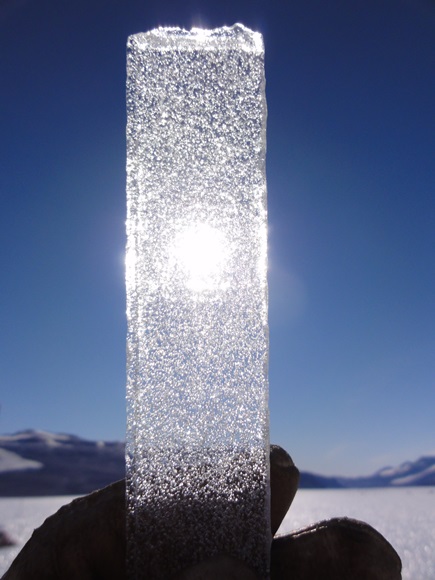A thermometer for the oceans

Air bubbles in an ice core from the Antarctic: the ice is up to 24'000 years old. Image: Bernhard Bereiter / Scripps Institution of Oceanography / Empa / University of Berne
The oceans are the largest global heat reservoir. As a result of man-made global warming, the temperature in the global climate system increases; around 90% of the extra heat is absorbed by the oceans. This means that the average sea temperature can tell us a lot about the state of our climate, both today and in the past. However, it is difficult to determine an accurate average value across all sea depths and regions of the world.
The results of previous measurement methods heavily depend on location, season or sea depth, which can lead to distorted results. As part of the WAIS Divide Ice Core Project, an international research team led by Bernhard Bereiter from the Scripps Institution of Oceanography – now working at Empa and the University of Bern – has developed a method of measuring ocean temperatures over the last 24'000 years with high accuracy.
These measurements have now been published in Nature. “Our study clearly shows that the basic idea – the connection between the concentration of noble gases in the atmosphere and the average ocean temperature – is correct and that the method works,” said Bereiter.
Eternal ice as contemporary witness
The work is based on ice cores from the Antarctic. The layers of eternal ice form an archive of the atmosphere, in which not only dust particles and solids but also air and other gases are trapped. In these bubbles one can determine the concentration of different gases. For once, it is not the usual suspects such as the greenhouse gases methane and carbon dioxide that play a role, but the noble gases krypton, xenon and argon, as Bereiter points out.
The principle can be explained as follows: cooling water absorbs noble gases from the atmosphere, while warming water releases noble gases into the atmosphere. The concentration of noble gases in the atmosphere thus allows conclusions to be drawn about the average global temperature of the sea – and not only the warmer ocean surface, but the mean temperature averaged over the entire mass of water to the very bottom of the sea.
A look into the past
The drill cores from the Antarctic ice cover the period of the past 24'000 years. During this time, the transition from the last ice age to the current warm age took place. This is also reflected in the results from drilling cores: the researchers found a significant rise in mean ocean temperatures; overall, the ocean warmed up by 2.6 degrees Celsius over a period of 10'000 years.
In the analysis of the data, Bereiter found that the increase in average global sea temperature is strongly correlated to the air temperature in Antarctica, which underscores the influence of the southern hemisphere on the global climate. Up to now, this type of temperature measurement can only be applied to very large changes such as the investigated transition from an ice age to a warm age. In theory, however, the method should also work to monitor current changes. These are (still) relatively small compared to the temperature changes investigated in the current study, which is why much more precise methods than are currently available are urgently needed, according to the Empa researcher.
Box: The WAIS Divide Ice Core Project
Ice cores are our only source of samples from the palaeo-atmosphere and are, therefore, extremely valuable for palaeo-climate research because they capture environmental parameters ranging, on local scales, from individual snowflakes to the entire Earth's atmosphere and, on time scales, from hours to hundreds of thousands of years.
They record numerous aspects of the Earth's climate system in a single archive with very high temporal resolution. The aim of the WAIS (West Antarctic Ice Sheet) Divide Ice Core Project is to investigate the climate from the last ice age to the present day with a much greater time resolution and dating accuracy than previously possible. This applies in particular to the analysis of atmospheric gases, water isotopes and chemicals.
Media Contact
All latest news from the category: Earth Sciences
Earth Sciences (also referred to as Geosciences), which deals with basic issues surrounding our planet, plays a vital role in the area of energy and raw materials supply.
Earth Sciences comprises subjects such as geology, geography, geological informatics, paleontology, mineralogy, petrography, crystallography, geophysics, geodesy, glaciology, cartography, photogrammetry, meteorology and seismology, early-warning systems, earthquake research and polar research.
Newest articles

Pinpointing hydrogen isotopes in titanium hydride nanofilms
Although it is the smallest and lightest atom, hydrogen can have a big impact by infiltrating other materials and affecting their properties, such as superconductivity and metal-insulator-transitions. Now, researchers from…

A new way of entangling light and sound
For a wide variety of emerging quantum technologies, such as secure quantum communications and quantum computing, quantum entanglement is a prerequisite. Scientists at the Max-Planck-Institute for the Science of Light…

Telescope for NASA’s Roman Mission complete, delivered to Goddard
NASA’s Nancy Grace Roman Space Telescope is one giant step closer to unlocking the mysteries of the universe. The mission has now received its final major delivery: the Optical Telescope…



